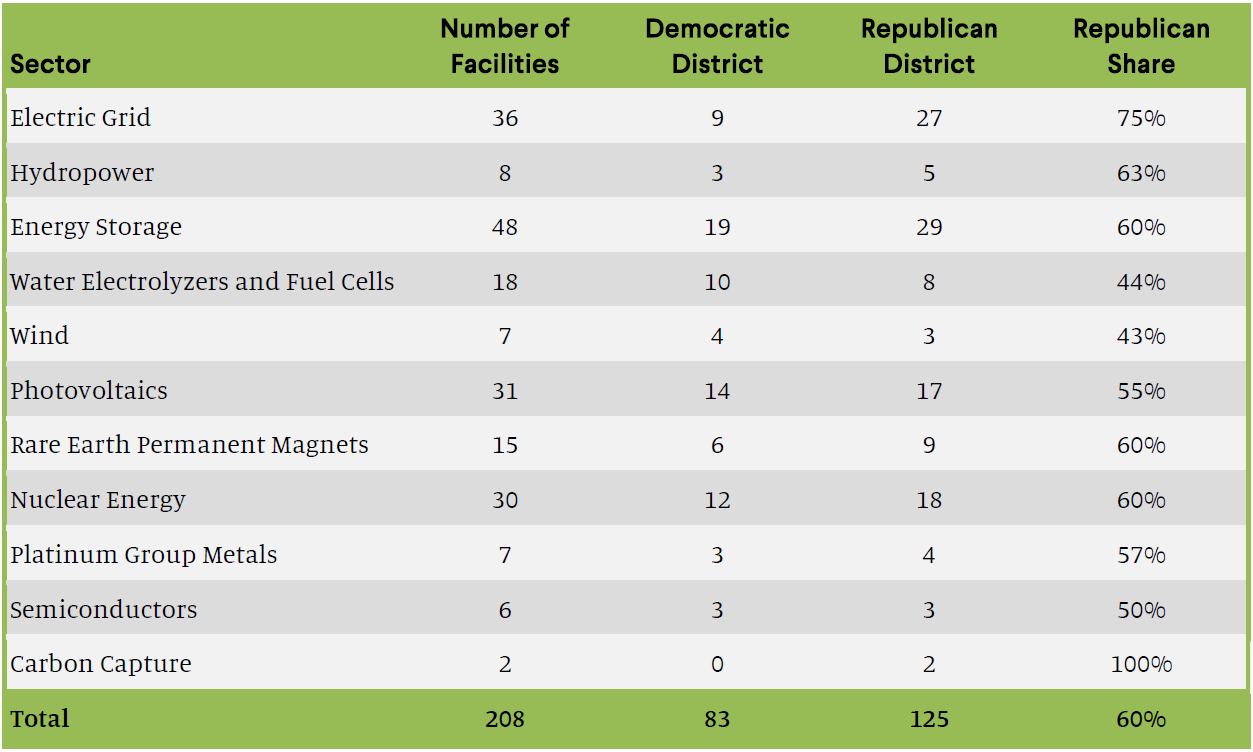Clean Energy Industrial Policy: A Go-To Issue with Nascent Bipartisan Appeal for Midterm Messaging
November 30, 2022
By Sunny Malhotra, Todd N. Tucker*
There were numerous wins for industrial policy in the most recent session of Congress, including the Inflation Reduction Act (IRA), the CHIPS and Science Act, the Infrastructure Investment and Jobs Act (IIJA), and the American Rescue Plan Act (ARPA). Last week, we examined the economic geography of clean energy supply chains. This week, we examine data from Department of Energy reports and 2022 election messages and outcomes, to shed light on the political geography and resonance of industrial policy.
A Bipartisan Map of Clean Energy Opportunities
As we previously noted, at least 208 facilities across 44 states and 141 congressional districts stand to gain from clean energy supply chain build out. This finding comes from a database of clean energy supply chain opportunities that we constructed through a thorough qualitative analysis of Department of Energy reports released earlier in 2022. It turns out that the majority of these economic development opportunities are in Republican districts. According to our calculations, the majority (60 percent) of the job opportunities for the clean energy transition are in districts that—as of 2022—were held by Republicans. For some sectors, the number is even higher: for example, 75 percent in production for the electric grid build out. This is notable, since 84 percent of congressional Republicans opposed the CHIPS Act, 89 percent opposed the IIJA, and 100 percent opposed the ARPA and IRA—all bills that represent iconic new developments of the industrial policy moment.
Table 1. Clean Energy Supply Chains by 2022 Congressional Districts and Party Control
 Source: Authors’ analysis of Department of Energy supply chain reports.
Source: Authors’ analysis of Department of Energy supply chain reports.
As we noted last week, our methodology led to a low estimate of potential supply chain opportunities, since we are only coding facilities mentioned in the Department of Energy’s supply chain reports from earlier this year. A much wider range of geographies and communities could—and should—be brought into the economic transition.
Figure 1. Map of Clean Energy Supply Chains by Congressional District and Party Control
Republican incumbents’ dismissal of industrial policy may have led to their leaving congressional seats on the table in a year when Democrats had one of the strongest midterm showings ever by a party in control of the presidency. Historians and other analysts will parse the many factors behind this outcome for years to come—from the role of attacks on abortion rights and democracy, to the shrinking appeal of former President Donald Trump. Yet one novel feature of many successful campaigns (from both parties, to some extent) was the prominent celebration of a relatively new approach to lawmaking: the promise of industrial policy for containing inflation and delivering a green economic transition.
US Senate: Incumbents Holding, Open Seat Candidates Gaining
First, let’s look at the Senate. There, Democrats appeared to at least hold their 50-50 margin, and may be able to even add one seat if they win in the runoff election in Georgia on December 6. A net pickup of one is a record bested only once in nearly 90 years.
In the Pennsylvania race in which Democrats seized an open seat previously held by Republicans, industrial policy was central to campaign messaging. This was evidenced most clearly by Senator-elect John Fetterman, who stated in campaign ads, “We don’t need to outsource any more Pennsylvania jobs to China . . . Making more sh*t in America brings jobs right here and fights inflation.” His campaign website states “We must make proper investments in greener, cleaner technology in America—and make more of that technology right here at home . . . I believe that clean energy can revitalize former steel towns all across Pennsylvania, including Braddock, the town I call home. It’s a total false choice that we have to choose between creating jobs and working towards a cleaner environment—we can and must do both.”
Fetterman was not alone in being buoyed—or at least was not hurt—by a pro-industrial policy message: Senators Raphael Warnock (D-GA), Mark Kelly (D-AZ), and Catherine Cortez Masto (D-NV) also celebrated their role in the passage of CHIPS, IIJA, and other laws in their election messaging.
US House: Incumbents on Defense
Now, let’s turn to the House. At the time of this writing, Democrats will have a net loss of around seven seats,1 a margin beaten only a handful of times since the creation of the modern party system around the time of the Civil War.
A strong defense played a key part in the relatively low margin of loss for Democrats during the midterms. Ohio’s 13th congressional district was one example where this played out. The seat was open because Rep. Tim Ryan ran for a US Senate seat and the race was rated a toss-up by the Cook Political Report prior to the election. In the race, Democrat Emilia Sykes beat Republican Madison Gesiotto Gilbert. After interviewing the candidates, the Akron Beacon Journal reported, “[Sykes] reflected on Akron’s history of being the rubber capital of the world before production moved around the world, taking opportunity with it. ‘What we can do and should do is revitalize manufacturing,’ she said, adding she’d support government policies that would rebuild supply chains and fairer trade policies.” When discussing inflation and economic hardship, Cleveland.com explained, “[Sykes] says efforts to increase the minimum wage and incentivize restoration of U.S. jobs that were shipped to other countries will create opportunity, improve the tax base and fight hopelessness. She cites construction of a new Intel plant in Ohio as an example.”
Other tight races saw incumbents being helped, or at least not hurt, by support of industrial policy, including Representatives Chris Pappas (D-NH) and Jahana Hayes (D-CT)—both of whom helped secure investments to unionized facilities that are among the facilities included in our database: Westinghouse Electric (represented by the Boilermakers 651 Lodge) in New Hampshire and FuelCell Energy (represented by the International Union of Operating Engineers (IUOE) Local 478) in Connecticut.
US House: New Candidates on Offense
A second part of Democrats’ strong performance was going on offense and picking up new seats. Democratic candidate Nikki Budzinski beat Republican Regan Deering in Illinois’s 13th congressional district (previously held by a Republican before a redistricting process), championing workers, unions, climate policies, and reshoring American manufacturing. Following the passage of the CHIPS Act, Budzinski released a statement of support, saying: “We need to re-invest in making things in the United States, take back the lead in manufacturing, and decrease our reliance on Chinese exports. The bipartisan CHIPs bill will mean American workers make more of the critical semiconductors that we use in everything from vehicles, household appliances, electronics, and high-tech manufacturing equipment.” Budzinski has also emphasized the importance of these reshored jobs being well-paying, union positions. Regarding proposed cuts to US steel jobs, Budzinski released a statement explaining, “My grandfather was a union painter and my grandmother a public-school teacher – I come from a union family and spent a decade working in the labor movement for firefighters, meatpackers, and grocery store workers. We must prioritize American steel and bring manufacturing back to Illinois, and I’ll never stop fighting for working families.”
By far the most surprising seat pick-up came in Washington State’s 3rd congressional district, the reddest seat to go blue this cycle. There, Democrat Marie Gluesenkamp Perez beat Republican candidate Joe Kent. After leading in early voting, Gluesenkamp Perez stated, “If tonight’s result stands, rest assured that I’ll stand up to both parties to bring back manufacturing and create local jobs, bring down the cost of gas and groceries and finally do something to make child care and health care affordable.” As an auto shop owner, she emphasized the need for more high quality goods being manufactured in the US. A key aspect of her platform involved supporting legislation that reshores critical American industries such as semiconductors, strengthening domestic supply chains, and achieving energy independence and sustainability while battling climate change.
Nascent Bipartisan Resonance
We now turn to some of the races where Republicans successfully channeled an industrial policy or industrial policy–adjacent message. In Ohio’s Senate race, Republican J.D. Vance ran on these themes, stating, “We should be promoting everything so that we can have energy independence again.” The Blade reported that Vance, “does not feel that expanding Ohio’s oil and natural gas industries means that the state has to abandon alternative energy options like wind, solar, and nuclear.”
These themes were also present in the toss-up races in which Republicans seized seats from Democrats. In New York’s 3rd congressional district, successful GOP candidate George Santos’s platform states, “We produce the cleanest energy in the world. Not only will becoming energy independent create thousands of jobs, but it will also make the cost of living cheaper all around.” In Virginia’s 2nd congressional district, Republican Jen Higgans ousted Democratic incumbent Elaine Luria; Higgans’ website stated that she will “prioritize protecting American jobs and intellectual property from being stolen by the CCP [Chinese Communist Party] to ensure China never dictates America’s future and we remain a leader on the world stage. She believes America must be much less dependent on China for manufacturing of our goods, medications, and technology.”
In Iowa’s 3rd congressional district, Republican Zach Nunn bested incumbent Democrat Cindy Axne. Nunn’s website states, “[W]e need someone who won’t blame our farmers for problems like climate change. We need a leader who understands our farmers are the solution. I’ll be a fighter who can help Iowa’s agriculture take advantage of new market opportunities like value-added production, carbon sequestration, and regenerative agriculture.” In the same race, Nunn wrote an op-ed slamming Democrats in Congress for not acting fast enough to bolster domestic manufacturing of semiconductors—a rare Republican call for more government action in industry. Nunn wrote, “Public-private investments in new semiconductor development can create jobs at home and secure U.S. technology independence… Ultimately, Congress bears the burden to bolster America’s semiconductor manufacturing. That’s no small task.”
Finally, in Oregon’s 5th congressional district, Lori Chavez-DeRemer picked up an open seat previously held by a Democrat who supported neoliberal trade policy, antagonized labor, and opposed much of the Biden agenda. On her website, Chavez-DeRemer’s website states, “Our trade deals should benefit Made In America products and companies, not foreign governments who violate their own citizens’ human rights.” Chavez-DeRemer was virtually alone among Republicans in endorsing the PRO Act, a pro-unionization piece of legislation that earned her support from (normally Democratic–aligned) labor unions.
Conclusion
The sheer breadth of industrial policy messages in campaigns across the country suggests that both policymakers and voters are eager for a future that moves past neoliberalism. Rather than leaving it up to markets and economic elites to decide what gets made where and by whom, the public appears to be embracing a more active and engaged government role in ensuring America has good jobs in the industries the country needs to survive and thrive. Crucially, as the data in this blog post show, there are both material and discursive openings for both parties to lean into industrial policy.
*Very special thanks to Ivan Cazarin, Keesa McKoy, and Michelle Wilczynski for research and technical assistance.
1 On election day, Democrats had 220 seats in the House to Republicans’ 213. Additionally, there were two vacancies in seats previously held by Democrats. As of this writing, it appears the reverse outcome will hold: Democrats with 213 seats, Republicans with 220, and two yet-to-be-called races that look favorable to the Republicans.
Clean Supply Chains: An Opportunity to Usher in a New Generation of Place-Based Strategies for Economic Development
Read more Opens in new window
